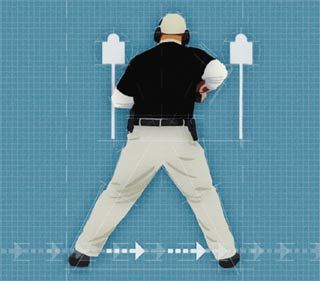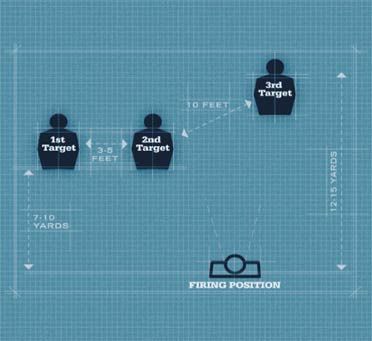Include multiple-target engagement in your training regimen
We’ve all shot multiple-target drills. To start, the shooter usually stands seven yards from three evenly spaced targets. A buzzer or whistle signals the beginning of the drill, which requires the shooter to fire a set number of shots on each target, either from the ready position or the holster. There might be a reload in the middle, or maybe not. The shooter usually stands still with no use-of-cover required. Normally, a very liberal time frame is placed on the drill — six shots in 20 seconds, something like that. The time frame must remain liberal because the intent is not to challenge the shooter, but to get them qualified in some type of multiple-target drill so they can go back on the street. After all, the goal is not to prepare the officer for what they’ll likely face if they’re involved in a gunfight with multiple adversaries (I could use the more palatable word “confrontation,” but gunfight is the reality); the goal is to meet some agency or state qualification mandate. After all, qualification is the same as preparation, right?
Some would have you think so, but nothing could be further from the truth. Let’s face facts: All defensive firearms training is artificial. It’s a method for preparing officers for armed conflict through skill-building, but there’s no way the stress and pandemonium of life and death can be incorporated into any training drill or scenario, including Airsoft or SIMUNITION, because the expectation or possibility of death has been all but eliminated. As trainers, we do the best we can, but there’s no way we can capture the reality of every possible situation our officers will face.
That said, some drills are better than others for preparing officers for a gunfight. The drill described earlier is a perfect example. It may be great for competition, but poor for fight preparation.
 Incorporate lateral movement into multiple target drills. This simple side-step works wonders in increasing an officer’s ability to prevail. |
I know I’ll get called on the carpet, so before I go any further, let me say that I like the classic El Presidente drill in which a shooter faces (or must pivot to face) three targets, draws from the holster and fires two shots on each of the three, reloads and either shoots two more or a single head shot on each. The drill has varied over the years, but follows the same basic format. I like the El Presidente not because it’s a multiple-target drill, but because it requires the shooter to perform a variety of skills all in one drill. For this purpose, it’s brilliant, but do not mistake what it really is.
Statistical studies of police gunfights, such as the FBI’s Officers Killed report or the NYPD’s SOP-9 survey, have made it quite clear officers will face multiple adversaries somewhere from 40–50 percent of the time. While I don’t place a great deal of faith in many statistical studies, it’s hard to ignore the large body of information telling us trainers that the likelihood of our officers facing more than one bad guy is quite high. Think about your own youth. Weren’t you more likely to get in trouble or do something dumb when you were with someone than when you were alone? It’s no different for criminals. They’re more emboldened when they’re in a wolf pack. When creating your agency’s lesson plan, give training for multiple adversaries a sizable chunk of the allotted training time. If you’re practicing on your own, include multiple-target engagement in your training regimen.
Dos & Don’ts
As with any defensive situation, awareness remains the key to dealing with multiple opponents. Avoid or evade any potential confrontation when possible, but like so many law enforcement functions, confrontation may be likely. After all, it’s our job as police officers to seek out and confront lawbreakers, but do so with all possible advantages. However, if you find yourself facing multiple bad guys alone, counter the attack with great speed and totally committed violence. First of all, move! Try to create as much distance between yourself and your attackers as possible. A moving target is harder to hit than a stationary one, so don’t just stand there and take incoming rounds. For every step (about three feet) you take, your ability to prevail multiplies because the farther away you can get from your opponent, the more your training is magnified while their ability to deliver a lucky hit decreases. Do not underestimate the lag time and confusion you can create for your opponents by moving in such a way that you get them in each other’s line of fire. Hell, use one of them for cover if it’s possible.
Don’t try to figure out which of them has the most deadly weapon. This is a game played by range officers who don’t understand the true dynamics of a gunfight. We’ve all played the “this guy has a shotgun and this one has a knife — whom do you shoot first” game. The fact is, all weapons are deadly. While you’re shooting the distant guy with the shotgun, the close guy might be cutting your throat with his knife. Deal with the close threat first. Better yet, shoot the close threat while you move to put him between you and the shotgun-wielding opponent. Yes, this may be wishful thinking, but it has worked in real confrontations. This is why those who understand human conflict will tell you gunfighting is a mental skill, not a physical one.
 Ensure targets vary in both distance from the shooter and from each other, as in this diagram. It is unlikely for hostiles to line up perfectly before an attack. |
When training for multiple opponent situations, you can use an El Presidente-like drill quite effectively. You can execute this drill against a single backstop, but if you can find a training location that has live-fire capability in multiple directions, all the better. Set up three targets 5–10 yards from where the shooter will start the drill. If possible, vary the elevation of each target so the shooter must look for them and adjust accordingly. Try to keep the shooter from just becoming a “tank turret” as they move from target to target. Set the targets at different distances with varied spacing so no pattern is obvious. To enhance realism, start the drill by uncovering the shooter’s face or having the shooter step out from behind something so they must respond instantly with no prior knowledge of the targets’ locations. Incorporate movement into the drill by directing the shooter to move laterally while they draw to engage the first target. If you can get stationary swinger/wobbler targets, tie them together with a rope or cord and pull on them so they also move during the drill. Such drills will get the shooter plenty pumped up.
When I conduct my training courses, I like to incorporate a drill that uses either Airsoft or SIMUNITION guns. I take two or three students and spread them out in front of the shooter with a variety of these guns, other weapons or empty hands. I give the shooter an Airsoft or SIMUNITION pistol in a holster. I cover the shooter’s face with a pillowcase and tell them to get ready. When the pillow case is pulled off, the shooter must instantly decide what’s going on, who is a threat, who needs to be shot and where to move to keep from getting shot. This drill incorporates both multiple targets and decision-making into the same drill. Needless to say, this drill has caused more than one person to melt down, but better in training than on the street.
Stay alert and check 360 often.
Dave Spaulding is a 28-year law-enforcement veteran, retiring at the rank of lieutenant. He currently works for a federal security contractor. He’s worked in all facets of law enforcement — corrections, communications, patrol, evidence collection, investigations, undercover operations, training and SWAT, and has authored more than 600 articles for various firearm and law enforcement periodicals. He is also the author of the best-selling books Defensive Living and Handgun Combatives.


